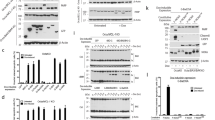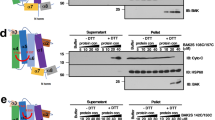Abstract
Bcl-2-related proteins are critical regulators of cell survival that are localized to the outer mitochondrial, outer nuclear and endoplasmic reticulum membranes1–4. Despite their physiological importance, the biochemical function of Bcl-2-related proteins has remained elusive. The three-dimensional structure of Bcl-xL, an inhibitor of apoptosis, was recently shown to be similar to the structures of the pore-forming domains of bacterial toxins5. A key feature of these pore-forming domains is the ability to form ion channels in biological membranes6,7. Here we demonstrate that Bcl-xL shares this functional feature. Like the bacterial toxins, Bcl-xL can insert into either synthetic lipid vesicles or planar lipid bilayers and form an ion-conducting channel. This channel is pH-sensitive and becomes cation-selective at physiological pH. The ion-conducting channel(s) formed by Bcl-xL display multiple conductance states that have identical ion selectivity. Together, these data suggest that Bcl-xL may maintain cell survival by regulating the permeability of the intracellular membranes to which it is distributed.
This is a preview of subscription content, access via your institution
Access options
Subscribe to this journal
Receive 51 print issues and online access
$199.00 per year
only $3.90 per issue
Buy this article
- Purchase on Springer Link
- Instant access to full article PDF
Prices may be subject to local taxes which are calculated during checkout
Similar content being viewed by others
References
White, E. Genes Dev. 10, 1–15 (1996).
Yang, E. & Korsmeyer, S. J. Blood 88, 386–401 (1996).
Lithgow, T., van Driel, R., Bertram, J. F. & Strasser, A. Cell Growth Differ. 5, 411–417 (1994).
Krajewski, S. et al. Cancer Res. 53, 4701–4714 (1993).
Muchmore, S. W. et al. Nature 381, 335–341 (1996).
London, E. Biochim. Biophys. Acta 1113, 25–51 (1992).
Cramer, W. A. et al. Annu. Rev. Biophys. Biomol. Struct. 24, 611–641 (1995).
Chen-Levy, Z. & Cleary, M. L. J. Biol. Chem. 265, 4929–4933 (1990).
Nguyen, M., Millar, D. G., Yong, V. W., Korsmeyer, S. J. & Shore, G. C. J. Biol. Chem. 268, 25265–2526 (1993).
Parker, M. W. & Pattus, F. Trends Biochem. Sci. 18, 391–395 (1993).
Choe, S. et al. Nature 357, 216–222 (1992).
Davidson, V. L., Heymann, J. B., Zhang, Y. L. & Cohen, F. S. J. Membr. Biol. 79, 105–118 (1984).
Zakharov, S. D., Heymann, J. B., Zhang, Y. L. & Cramer, W. A. Biophys. J. 70, 2774–2783 (1996).
Lam, M. et al. Proc. Natl Acad. Sci. USA 91, 6569–6573 (1994).
Zhu, W. et al. EMBO J. 15, 4130–4141 (1996).
Perez-Terzic, C., Pyle, J., Jaconi, M., Stehno-Bittel, L. & Clapham, D. E. Science 273, 1875–1877 (1996).
Mannella, C. A. Trends Biochem. Sci. 17, 315–320 (1992).
Zoratti, M. & Szabo, I. Biochim. Biophys. Acta 1241, 139–176 (1995).
Zamzami, N. et al. J. Exp. Med. 183, 1533–1544 (1996).
Liu, X., Kim, C. N., Yang, J., Jemmerson, R. & Wang, X. Cell 86, 147–157 (1996).
Martin, S. J. & Green, D. R. Cell 82, 349–352 (1995).
Slatin, S. L., Abrams, C. K. & English, L. Biochem. Biophys. Res. Commun. 169, 765–772 (1990).
Hoch, D. H. et al. Proc. Natl Acad. Sci. USA 82, 1692–1696 (1985).
Raymond, L., Slatin, S. L. & Finkelstein, A. J. Membr. Biol. 84, 173–181 (1985).
Wistow, G. Trends Biochem. Sci. 18, 301–306 (1993).
Tomarev, S. I. & Piatigorsky, J. Eur. J. Biochem. 235, 449–465 (1996).
Peterson, A. A. & Cramer, W. A. J. Membr. Biol. 99, 197–204 (1987).
Cramer, W. A. & Knaff, D. B. Energy Transduction in Biological Membranes, a Textbook of Bioenergetics (Springer, New York, 1990).
Györke, S. & Fill, M. Science 260, 807–809 (1993).
Author information
Authors and Affiliations
Rights and permissions
About this article
Cite this article
Minn, A., Vélez, P., Schendel, S. et al. Bcl-xL forms an ion channel in synthetic lipid membranes. Nature 385, 353–357 (1997). https://doi.org/10.1038/385353a0
Received:
Accepted:
Issue Date:
DOI: https://doi.org/10.1038/385353a0
This article is cited by
-
Mechanisms of BCL-2 family proteins in mitochondrial apoptosis
Nature Reviews Molecular Cell Biology (2023)
-
Non-endometrioid and high-grade endometrioid endometrial cancers show DNA fragmentation factor 40 (DFF40) and B-cell lymphoma 2 protein (BCL2) underexpression, which predicts disease-free and overall survival, but not DNA fragmentation factor 45 (DFF45) underexpression
BMC Cancer (2018)
-
Alcohol and thiamine deficiency trigger differential mitochondrial transition pore opening mediating cellular death
Apoptosis (2017)
-
Mimicking the cell membrane: bio-inspired simultaneous functions with monovalent anion selectivity and antifouling properties of anion exchange membrane
Scientific Reports (2016)
-
Cdk2 phosphorylation of Bcl-xL after stress converts it to a pro-apoptotic protein mimicking Bax/Bak
Cell Death Discovery (2016)
Comments
By submitting a comment you agree to abide by our Terms and Community Guidelines. If you find something abusive or that does not comply with our terms or guidelines please flag it as inappropriate.



